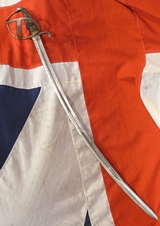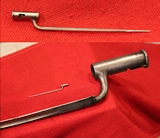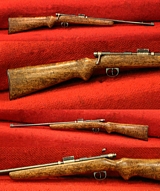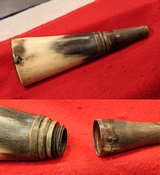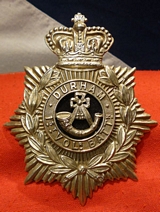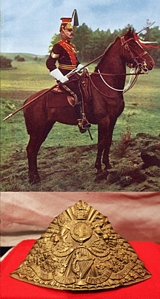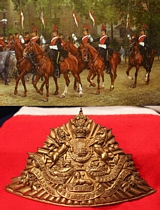Antique Arms & Militaria
A Rare, Victorian, British Royal Engineer's Sword, Prussian Designed, British Army Issue, Experimental Sword of The Royal Engineers, The Driver's Sword, Model of 1850
Used in the Crimean War, and for sale as a very, very inexpensive rare Royal Engineers sword, due to its pitted surface. This sword was originally a Prussian experimental cavalry sword that was once issued for testing, to a limited number of Prussian Hussar regiments, in 1850. It was in fact not actually finally approved by the Prussians, but it's form was continued and developed until it's successor sword eventually evolved to become the Prussian Model of 1852 Cavalry Hussar Sabre. Those experimental 1850 swords were withdrawn from service by the Prussian Cavalry, and they were placed in storage in Liege in Belgium for disposal.
There was an article published in the "Deutsches Waffen Journal" about this sword. On the sword they had, it had on the guard, the regimental marking of the 4th squadron, Prussian Garde-Husaren regiment and on the spine of blade a crowned FW 50 and German D mark. This confirms it was the Prussian Hussar experimental issue of 1850. On the ricasso was an S&K marking with Crowned L 8 and two British Ordnance broad arrows to show that this pattern of sword was thus purchased and re-issued to the British army. So, these very rarely seen swords are recorded as the Royal Engineers 1850 Driver's pattern swords, but they were originally known as the Prussian experimental Hussar sword, that after disapproval were then removed to Liege and later sold to the British Ordnance through the Liege armourers. It came from the descendant family of a Crimean War Royal Engineer. Our example is certainly age worn, in fact none of it's original markings are now still visible unfortunately. However, it is a most rare and fascinating piece. To collectors of British [and Prussian] swords this would make a most fascinating addition, especially, that if particularly searched for, it may take many years to find another, if at all. The condition is certainly not good, but its rarity and significance is considerable. All over russetted, no scabbard, damaged grip. There used to be an example identical to this one in the Royal Small Arms Factory Enfield. Pattern Room read more
395.00 GBP
Very Special Offer!! Many Have Been Reserved Just 5 Remaining As Not Yet Reserved A Fabulous, Original Set of Antique MK II Zulu War &1880's Vintage Martini Henry Rifles
Special one off offer items. We are sending them individually to be conserved and stock restored but as requested and as required. The stocks and all steel parts are very good but some stock cracking needs attention etc. our artisan can attend to that near invisibly. All the rifles are with original Victorian era leather slings.
These the very types of MK IIs as were used by the 24th Foot at Ishandwhana and Rorkes Drift. All of them are original ordnance contract examples, made either by Enfield, Birmingham Small Arms or London Small Arms, all with VR Crown mark, all originally line regiment issue. All sold on an individual basis . As they are incredibly collectible it is most unlikely they will remain available for long.
These rifles are truly exceptional examples, maker marked, and in very good operational order indeed with an excellent action, and clearly combat used. All their cleaning rods are present but usually no longer removable.
The Martini Henry, .450 577 rifle was most famous British Infantry breech loading rifle of the 19th century. All of these rifles are just as were used in the film ZULU, and the exact type as was used during the 1879 Zulu War, all very nice examples.
The Martini-Henry was a breech-loading lever-actuated rifle adopted by the British, combining an action worked on by Friedrich von Martini (based on the Peabody rifle developed by Henry Peabody), with the rifled barrel designed by Scotsman, Alexander Henry. It first entered service in 1871 replacing the Snider-Enfield, and variants were used throughout the British Empire for 30 years. It was the first British service rifle that was a true breech-loading rifle using metallic cartridges.
During the Martini-Henry period in service, the British army were involved in a large number of colonial wars, most notably the Anglo-Zulu War in 1879. The Martini Henry, 450-577, Short Lever, [MK I converted] MK II or the regular MK II rifle was the type used by the company of the 2nd Battalion, 24th Regiment of Foot present at Rorke's Drift during the eponymous battle. The MK I originally had a small design fault in that the actions hinge pin was initially made of brass, which was too soft for continual use. The rare and early MKI's were thus converted by removing this pin, replacing it with a steel pin, and then redesignated the MKII. The later dated 1880's examples we have were used throughout the British empire. This fabulous set, will now be sold individually, and were used for lecture purposes for almost 15 years at various military bases around the country
As with all our original antique arms, no licence is required to own, purchase or to collect anything of that description we sell. They, and all of these rifles, are entirely unrestricted to own, collect, and display just as they are, however, we only permitted to sell to those who are over 18 of age [with suitable I.d.] read more
Price
on
Request
A Miniature Waterloo Period 'Brown Bess' Musket Bayonet
Original hand engineered miniature, made post war by renown miniaturist engineer Ronald Platt. Photographed alongside the original bayonet to show perspective. the Third or India Pattern became the standard British musket in use throughout the remainder of French Revolutionary and Napoleonic Wars and was used in almost every theatre in which the British were present. It was the musket that the British soldier carried during the Peninsular War and the Hundred Days campaign including both the battles of Quatre Bras and Waterloo. It was also used in the War of 1812 in North America. read more
50.00 GBP
An Early Fine Miniature Single Shot Bolt Action Rifle
Showing all the minute detail of the original bolt action rifle. European armies continued to develop bolt-action rifles through the latter half of the nineteenth century, first adopting tubular magazines as on the Kropatschek rifle and the Lebel rifle, a magazine system pioneered by the Winchester rifle of 1866. The first bolt-action repeating rifle was the Vetterli rifle of 1867 and the first bolt-action repeating rifle to use centerfire cartridges was the weapon designed by the Viennese gunsmith Ferdinand Fruwirth in 1871. Ultimately, the military turned to bolt-action rifles using a box magazine; the first of its kind was the M1885 Remington Lee, but the first to be generally adopted was the British 1888 Lee-Metford. World War I marked the height of the bolt-action rifle's use, with all of the nations in that war fielding troops armed with various bolt-action designs. Probably a Colt or Remington pattern. 6 inches long Non working original hand engineered miniature, made post war by renown miniaturist engineer Ronald Platt. read more
275.00 GBP
A Georgian 18th century Carved Horn Primer or Pistol Flask
made in the 18th and used into the early 19th century. With powder measure screw on cap. Cow horn with wooden base plate.
Firearms became more and more sophisticated during the 16th-century but still required a number of accessories to load and operate them. The main charge, placed in the barrel with the shot, was carried in the powder flask. Smaller priming flasks contained fine-grain powder for priming the pans of wheel-lock firearms. Flasks were attached to a bandolier, a type of sling worn over the shoulder or around the waist, from which hung the various accessories required for a weapon including spanners for the mechanism, measured charges, powder flasks and priming flasks. read more
220.00 GBP
A Victorian Durham Light Infantry Helmet Plate Ist Volunteer Battalion
In white metal with black centre. The 1st Durham Rifle Volunteer Corps was formed at Stockton-on-Tees in 1860, and in 1880 was amalgamated with other Durham corps, from Darlington, Castle Eden and Middlesbrough, to form a battalion of eight companies.
The 1st Durhams later became the 1st Volunteer Battalion of the Durham Light Infantry and as such gained the battle honour `South Africa 1900-02' for the services of its members during the Boer War. read more
175.00 GBP
Many Wonderous Pieces Added Every Day. There is Probably Nowhere Else In The World You Can View Such Fabulous & Historical Wonders,.. & Where Everything Is For Sale
All under one roof, intriguing and collectable artefacts, and specialist 1st edition rare books, plus militaria such as, an original, huge, and very rare 88mm WW2 Shell from a German 'King Tiger' tank, ranging to an original Imperial Roman Legionary’s gladius sword, a museum quality samurai sword by one of the great sword makers of early 14th century Japan. Or, a most rare, and absolutely stunning museum grade Christian samurai’s sword from circa 1630.
These past few weeks we have added, and are still adding, original, ancient artefacts, from Rome, France, Carthage, Persia, Greece, and Britain, many from fine English collections, originally acquired in the early 19th century, and then re-acquired from the descendants of those original collectors, in the 1990’s or even before by other collectors who subsequently sold them to us.
We have thousands of pieces, that you can can view [and buy] from our website. View and buy such treasures as a 2000 year old roman soldier's gladius sword, from the time of Julius Caesar, Augustus and Nero. A museum grade 1000+ year old sword of a Viking chieftain, king or earl [in Viking times called a jarl] that is inlaid with traces of knotwork silver inlay. A bronze and iron Archemeanid sword from the time of the Greco-Persian wars of Xerxes the Great against the Spartans at Thermopylae, or a Circa 2,500 Scythian infantry warrior’s bronze helmet. Plus, Imperial Roman 1st and 2nd century rings, the type such as worn by a Roman freed gladiator, or, the owner of slave gladiators, the Imperial Pretorian Guard, legionary officer's or nobles, often with the traditional symbols and figures, from the time of the Emperors Augustus, Tiberius, Caligula, Claudius and Nero. A superb 3rd to 4th century BC Falcata sword similar to the Greek Kopis, the sword used by Hannibal’s army in the 2nd Punic War and his invasion of Rome across the Alps, and a 3rd Century Imperial Roman Sword, from the time of Emperor Constantine and the Battle of Cibalae. Plus a remarkable 900 to 1066 period Original Viking- Norman Iron Four Plate Helmet, as seen depicted in the world famous so-called Bayeux Tapestry, plus, early and rare books, such as, an original very early printing of a 5th century Roman treatise on Roman warfare, and an 18th Century biography on 18th century Warfare, or a very rare 15th century incunabula by Bartolomeus Platina personally commissioned by Pope Sixtus IV.
Plus, as usual, many, many thousands of pieces of historical interest, from one of the oldest and still thriving [if not the oldest surviving] traditional, purveyors of original ancient, antique and vintage historical militaria, companies in Europe, family based through generations in the city of Brighton, and for over 100 combined years located in the Brighton Lanes.
Our family partners Mark and David have dedicated between them, a combined 90 plus years together, serving the world's collectors. Some are the simplest of collectors, some with most eclectic tastes, covering all fields of interest spanning millennia, others, highly specific, if not profound. Very recently we found for a specialist book collector a most rare ‘Subscriber’s Edition’ 1926 Seven Pillars of Wisdom, by T.E. Lawrence, a book that the collector had been searching for for 20 years, and we had joined in that search for him around 10 years ago. He had seen two volumes of that edition around 10 years ago, but discounted both of them, as not quite the perfect volume he was looking for. The dedication of a collector who could spend 20 years to find a single book, that specifically suited his needs, is simply remarkable, although strangely, not that unusual in our line of country. Despite the fact that the book we found for him was approaching six figures, he actually had spent over twice that sum during his 20 year worldwide search to find just the perfect one he was looking for. When asked by us which specific book he was seeking of that printing, he replied that he didn’t actually want or need a perfect condition example at all, just the one that was perfect for him “ I am not entirely sure which one I seek, but I’ll know it when I hold it”
The best part of our field is that, in the most part, of all of what we regularly offer can be remarkably affordable compared to almost every other form of fine and rare collectable. For example, the best available fine art paintings etc. can run into millions, even hundreds of millions of pounds, the finest pieces of furniture can run into hundreds of thousands or even millions, the best silver, coins or stamps can also be worth millions, and even 20th century motor cars can reach tens of millions of pounds. So although some of our pieces might appear expensive, by comparison to almost every other field in the world of collecting, they can be amazingly affordable to all and every rank of collector.
We suppose that is our raison d’etre, every year we buy many thousands of pieces, and pass them on to similarly thousands of collectors, from postmen to presidents, from Chelsea pensioners to field marshals, from law clerks to Lord Chancellors. I [Mark] remember one such interesting and jolly conversation, I and my wife Judith had over lunch, with the soon to become Lord Chancellor Quentin Hogg, in Jermyn St., during our London honeymoon in 1978. Judith had, on occasion before our marriage, worked with Sir Michael Havers, [Quentin’s successor as Lord Chancellor in 1987] so they had mutual acquaintance. The general chit chat got around to the efficacy of hanging, the effectiveness of the hangman’s knot, against the much earlier system of the executioner’s axe that was only afforded only to those of high status!. Quentin remarked at the conclusion [tongue in cheek] “ I have a little list of likely candidates, just in case it is re-introduced”
By way of coincidence, a few years later we sold a 16th century executioner’s axe to a ‘Beefeater’ Yeoman Warder of the Tower of London, Geoffrey Abbot, near identical to one that executed Lady Jane Grey, who was proclaimed Queen of England in 1553, reigned for just 9 days and subsequently executed within the grounds of the Tower, aged just 16 or 17, and our former axe appears amongst other places, illustrated in his books on the execution at Tower of London. He was even consulted some years later for the execution of Saddam Hussein.
Many of our collectors have become lifelong and dear friends, with conversations on every subject imaginable, covering every conceivable avenue of interest, and it has been a privilege to know every single one, friendships valued beyond pearls. read more
Price
on
Request
A Good Victorian Fifth Royal Irish Lancers Tchapka Helmet Plate
In superb condition, fabulous bronze patina and two helmet screw posts.Queen Victoria's crown. The regiment was originally formed in 1689 as James Wynne's Regiment of Dragoons. They fought in the Battle of the Boyne and at the Battle of Aughrim under William of Orange. Renamed the Royal Dragoons of Ireland, they went on to serve with the Duke of Marlborough during the Spanish War of Succession and earned three battle honours there.In 1751, they were retitled 5th Regiment of Dragoons and in 1756 the 5th (or Royal Irish) Regiment of Dragoons. As such, they served in Ireland and were active during the Irish Rebellion of 1798. However, they were accused of treachery; their accusers claimed their ranks had been infiltrated by rebels. (According to Continental Magazine, April 1863, the unit refused to attack a group of rebels.) This accusation appears to have been false, but nevertheless they were disbanded at Chatham in 1799. The regiment was reformed in 1858, keeping its old number and title, but losing precedence, being ranked after the 17th Lancers. It was immediately converted into a lancer regiment and titled 5th (or Royal Irish) Regiment of Dragoons (Lancers). In 1861, it was renamed the 5th (or Royal Irish) Lancers and then the 5th (Royal Irish) Lancers. The regiment served in India and a section served in Egypt in 1885, taking part in the battles at Suakin. It served with distinction in the Second Boer War from 1899 to 1902, gaining battle honours at Battle of Elandslaagte and The Defence of Ladysmith.
The regiment then returned to England where it stayed until the outbreak of World War I, when it became part of the British Expeditionary Force and saw action continually from 1914 to 1918 in some of the war's bloodiest battles. During the battle of Bourlon Wood George William Burdett Clare received the Victoria Cross posthumously. The 5th (Royal Irish) Lancers won a total of 20 battle honours during the Great War.
The 5th (Royal Irish) Lancers also has the grim honour of being the regiment of the last British soldier to die in the Great War. This was Private George Edwin Ellison from Leeds, who was killed by a sniper as the regiment advanced into Mons a short time before the armistice came into effect.
The regiment was renamed 5th Royal Irish Lancers and disbanded in 1921, but a squadron was reconstituted in 1922 and immediately amalgamated with the 16th The Queen's Lancers to become the 16th/5th Lancers The Royal Irish Lancers were in Mons at the time of retreat in 1914 but escaped and returned on Armistice Day. The last cavalry regiment out and the first back!. The memorial panel we show in the gallery records the return welcomed by the Maire and the Cur?. The scene is taken from a painting, ?5th Lancers, Re-entry into Mons?, last heard of in the private collection of a Belgian citizen. This in turn is almost a mirror image of a painting ?5th Lancers, Retreat from Mons? (whereabouts unknown). In the former, the troopers are heading in the opposite direction to the ?Retreat?, and a middle-aged priest and a pregnant woman watching the departure of the regiment among a worried-looking crowd of Belgian citizens have subtly changed: the priest is now white-haired and the mother holds up her four-year-old child, having lived through the occupation of the German forces in Mons for four years. The Great War 1914
The 5 Lancers, as part of the 3rd Cavalry Brigade, were heavily involved and played a major role in the initial mobile actions fought by the BEF. They gained the distinction of being the last cavalry regiment to withdraw from Mons during the retreat; they also had the privilege to be the first British regiment to re-enter Mons after the pursuit in November 1918. Generally the First World War is described as a war of trench deadlock primarily fought by the infantry, gunners and engineers, this assessment is correct. It must however be remembered that cavalry regiments were expected to take their place in the line from time to time and did share the privations of trench warfare suffered by the infantry. On a number of occasions 5 L particularly distinguished themselves: in the defence of Guillemont Farm, June 1917, 3 MCs, and 4 MMs were won and during the defence of Bourlon Wood in 1918 Private George Clare won a posthumous VC. While the main focus of the First World War remained with the armies fighting on the western front it was by no means the only theatre of war. In 1918 Allenby, a 5th Lancer and later a Field Marshal, reorganised British forces in the Middle East pushing his lines forward into northern Palestine. Allenby's Army broke through at Megiddo resulting in the collapse of Turkish resistance. 8.25 inches x 5 inches approx. read more
295.00 GBP
A Good & Scarce, Victorian, 12th Lancers Helmet Plate With Battle Honours
In patinated brass. With two screw posts. With it's Victorian, pre Boer War battle honours; Egypt, Salamanca, Peninsula, Waterloo, South Africa 1851-2-3, Sevastopol, Central India. The regiment of dragoons that was to become the 12th Royal Lancers was raised by Brigadier-General Phineas Bowles in Berkshire in July 1715 against the threat of the Jacobite rebellion. In 1718 the regiment was placed on the Irish establishment and posted to Ireland, where it remained for seventy-five years.
In 1751 the regiment was officially styled the 12th Dragoons. In 1768 King George III bestowed the title of The 12th (Prince of Wales's) Regiment of (Light) Dragoons, the regiment was given the badge of the three ostrich feathers, and the motto "Ich Dien". The 12th Dragoons, led by General Sir John Doyle won their first battle honour in Egypt in 1801 against the French Dromedary corps.[3] They had previously had a young Duke of Wellington serve with them as a subaltern between 1789?91. In 1816, the 12th Light Dragoons were armed with lances after the cavalry of Napoleon's Army had shown their effectiveness at Waterloo and were re-titled 12th (The Prince of Wales's) Regiment of (Light) Dragoons (Lancers). In 1855 they reinforced the Light Cavalry Brigade in the Crimea after the Charge of the Light Brigade at Balaclava. In 1861, they were renamed 12th (The Prince of Wales's) Royal Regiment of Lancers. Between 1899 - 1902 they fought in the South African War, taking part in the Relief of Kimberley and Diamond Hill, the last battle of the war. read more
245.00 GBP
A Very Nice Original Simkin Watercolour of an Officer 2nd Lifeguards 1876
Simkin was born in Herne Bay, Kent, on 5 November 1850, (some references cite 1840) the son of a commercial traveller, also named Richard. After marrying his wife, Harriet, in 1880, He spent much of his time at Aldershot, Hampshire, and may also have been a volunteer in the Artists Rifles. He was employed by the War Office to design recruiting posters, and to illustrate the Army and Navy Gazette. In 1901, he created a series of 'Types of the Indian Army' for the Gazette. he obtained much of the information from the Colonial and India Exhibition of 1886. During his lifetime, he, along with Orlando Norrie produced thousands of watercolours depicting the uniforms and campaigns of the British Army. Simkin also contributed illustrations to numerous publications including the Boy?s Own Magazine, The Graphic and others; many were published by Raphael Tuck and sons.
He died at his home at 7 Cavendish Street, Herne Bay on 25 June 1926, survived by his wife and two daughters. Today, his pictures can be seen in numerous regimental museums and his illustrations appear in regimental histories, 7 inches x 9.8 inches read more
595.00 GBP


